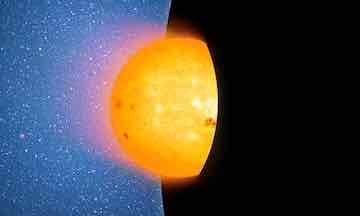Observations suggest that black holes swallow doomed stars whole, increasing the mystery surrounding these celestial monsters
Of all the mysteries in the universe, black holes surely top the list. They have such strong gravitational fields that once an object falls in, it will never be able to escape.
What then happens to that object is a total mystery that current physics cannot answer. Our best ideas suggest that in the overwhelming gravity, matter is simply crushed out of existence – but what does that actually mean? Can it really happen?
When you think about it, it all just sounds just a bit too sci-fi-ish. Maybe its even enough to tie your brain in such knots that you spontaneously exclaim ‘covfefe!’.
Black holes were predicted to exist in the early part of the 20th century by Einstein’s general theory of relativity, and were met with wide-spread scepticism from physicists and astronomers.
Although most now accept that black holes must exist, there is no killer piece of evidence that proves them beyond doubt. This means that some researchers continue to wonder whether something unknown halts the collapse before the gravitational field becomes strong enough to create the black hole.
The key characteristic of a black hole is the ‘event horizon’. This is the invisible boundary that separates it from the rest of the Universe. If a star crosses the event horizon it would simple wink out, like a light being turned off.
However, if something halted the formation of the black hole, then there would be a solid surface for the star to strike. In this case, the collision would cause the object to flare up in brightness.
Now, astronomers from University of Texas at Austin and Harvard University, have worked out that the flare would last for months or years as the smashed star’s gas cooled down. And they’ve been looking for such outbursts.
They searched the Pan-STARRS archive for signals. This 1.8-metre telescope in Hawaii has recently completed a 3.5-year survey of half the northern sky, specifically looking for things that change brightness.
The team looked at the centre of galaxies, where supermassive black holes (or their equivalents) are thought to reside. They calculated that in 3.5 years they should see around 10 flares if the objects were solid rather than black holes.
They saw no flares at all. This strengthens the case that the objects at the centre of galaxies are indeed black holes that swallow stars whole and not compact, solid objects.
Astronomer Ramesh Narayan, one of the authors of the study, told the Royal Astronomical Society: “Our work implies that some, and perhaps all, black holes have event horizons and that material really does disappear from the observable universe when pulled into these exotic objects, as we’ve expected for decades.”
But don’t put the flags out just yet. Although the work adds to the substantial body of circumstantial evidence for the existence of black holes it yet again stops short of being the smoking gun that absolutely proves their existence.
What we would really like to see is the light from a swallowed star disappearing from view. Well, perhaps we did see something like this back in 1992.
Nasa astrophysicist Joseph F. Dolan used data from the ultraviolet instrument on the Hubble Space Telescope to keep tabs on the black hole candidate Cygnus X-1, located 6000 light years from Earth.
Dolan’s research identified two ultraviolet signals that each looked like a luminous cloud of gas spiralling towards the black hole before disappearing completely, as would be expected when it crossed the event horizon.
These were tantalising observations but frustratingly such signals have not been seen again despite other searches. But now, there is renewed hope that proof may be just around the corner.
The Event Horizon Telescope is currently collecting and analysing data that could show us the event horizon of the black hole thought to sit in the centre of our own galaxy. If it succeeds, then the hard work begins.
Scientists will have to fully face up to the Herculean task of explaining what happens inside a black hole. Only by stepping beyond Einstein to a quantum theory of gravity will they be able to do that.
Source: The Guardian

































Leave a Comment
You must be logged in to post a comment.